A rare
Page 23
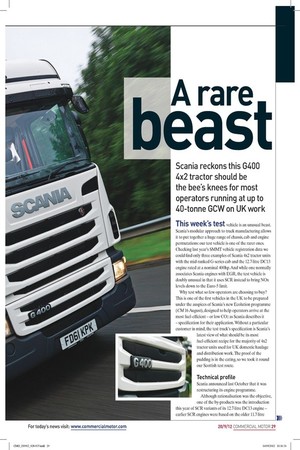
Page 22
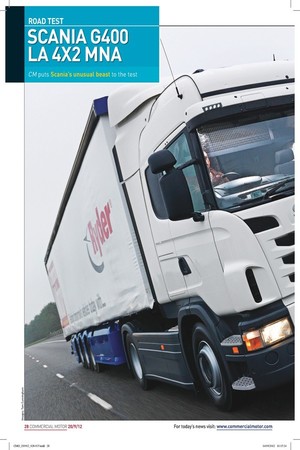
Page 24
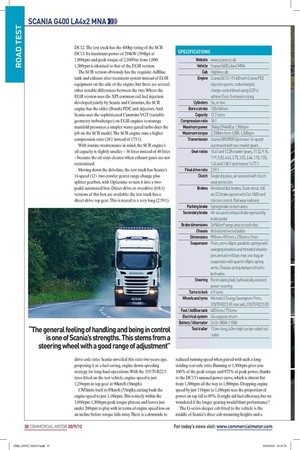
Page 27

Page 28
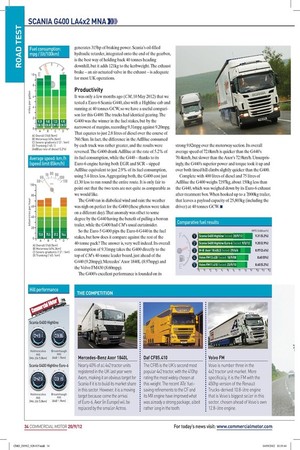
Page 25
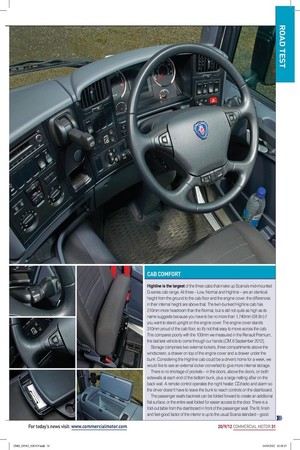
Page 29
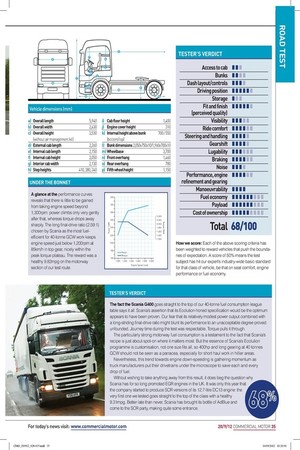
If you've noticed an error in this article please click here to report it so we can fix it.
ROAD TEST
SCANIA G400
LA 4X2 MNA CM puts Scania’s unusual beast to the test
Scania reckons this G400 4x2 tractor should be the bee’s knees for most operators running at up to 40-tonne GCW on UK work
This week’s test
vehicle is an unusual beast. Scania’s modular approach to truck manufacturing allows it to put together a huge range of chassis, cab and engine permutations: our test vehicle is one of the rarer ones. Checking last year’s SMMT vehicle registration data we could ind only three examples of Scania 4x2 tractor units with the mid-ranked G-series cab and the 12.7-litre DC13 engine rated at a nominal 400hp. And while one normally associates Scania engines with EGR, the test vehicle is doubly unusual in that it uses SCR instead to bring NOx levels down to the Euro-5 limit.
This week’s test
Why test what so few operators are choosing to buy? This is one of the irst vehicles in the UK to be prepared under the auspices of Scania’s new Ecolution programme (CM 16 August), designed to help operators arrive at the most fuel-eficient – or low CO2 as Scania describes it – speciication for their application. Without a particular customer in mind, the test truck’s speciication is Scania’s
latest view of what should be its most fuel-eficient recipe for the majority of 4x2 tractor units used for UK domestic haulage and distribution work. The proof of the pudding is in the eating, so we took it round our Scottish test route.
Technical profile
Scania announced last October that it was restructuring its engine programme. Although rationalisation was the objective, one of the by-products was the introduction this year of SCR variants of its 12.7-litre DC13 engine – earlier SCR engines were based on the older 11.7-litre DC12. The test truck has the 400hp rating of the SCR DC13. Its maximum power of 294kW (394hp) at 1,900rpm and peak torque of 2,100Nm from 1,0001,300rpm is identical to that of the EGR version.
The SCR version obviously has the requisite AdBlue tank and exhaust after-treatment system instead of EGR equipment on the side of the engine, but there are several other notable differences between the two. Where the EGR version uses the XPI common-rail fuel injection developed jointly by Scania and Cummins, the SCR engine has the older (Bosch) PDE unit injectors. And Scania uses the sophisticated Cummins VGT (variable geometry turbocharger) on EGR engines to manage manifold pressures; a simpler waste-gated turbo does the job on the SCR model. The SCR engine runs a higher compression ratio (18:1 instead of 17.3:1).
With routine maintenance in mind, the SCR engine’s oil capacity is slightly smaller – 36 litres instead of 40 litres – because the oil stays cleaner when exhaust gases are not recirculated.
Moving down the driveline, the test truck has Scania’s 14-speed (12+ two crawler gears) range-change plus splitter gearbox, with Opticruise to turn it into a twopedal automated box. Direct-drive or overdrive (0.8:1) versions of this box are available: the test truck has a direct-drive top gear. This is mated to a very long (2.59:1) drive-axle ratio. Scania unveiled this ratio two years ago, proposing it as a fuel-saving, engine down-speeding strategy for long-haul operations. With the 315/70 R22.5 tyres itted on the test vehicle, engine-speed is just 1,256rpm in top gear at 90km/h (56mph).
CM limits itself to 85km/h (53mph), cutting back the engine speed to just 1,186rpm. This is nicely within the 1,000rpm-1,300rpm peak torque plateau and leaves just under 200rpm to play with in terms of engine speed loss on an incline before torque falls away. There is a downside to reduced running speed when paired with such a longstriding rear-axle ratio. Running at 1,300rpm gives you 100% of the peak torque and 97.5% of peak power, thanks to the DC13’s unusual power curve, which is almost lat from 1,300rpm all the way to 1,900rpm. Dropping engine speed by just 114rpm to 1,186rpm sees the proportion of power on tap fall to 89%. It might aid fuel eficiency, but we wondered if the longer gearing would blunt performance?
The G-series sleeper cab itted to the vehicle is the middle of Scania’s three cab-mounting heights and a reasonable compromise between interior space and accessibility for UK distribution work.
List price for the G400 LA 4x2 MNA with the Highline cab is £77,950. The list of extras on the test vehicle is pretty long, including electronic stability programme (ESP) at £1,600, Opticruise transmission at £1,500, air delectors are £1,250, automatic air-con £1,100, side skirts £950 and 315/70 R22.5 Michelin X Energy Savergreen tyres £420. All the extras add up to almost £10,000, taking the list price to £87,500 (plus VAT).
On the road
Part of the Ecolution recipe is reducing the speed-limiter’s setting to 85km/h. At this road speed the engine produces exactly the same torque as if the truck was travelling at 90km/h, but with less engine speed in reserve before torque begins to fall. There is also around 33hp less power available than at 90km/h. With just below the usual 10hp/ tonne rule of thumb even at peak power, this loss of 33 horses potentially becomes more signiicant.
In fact, as the M6 undulated its way northwards, the Scania coped with this modest loss of power with no discernible loss of momentum, although hitting ascents at a slower approach speed brings the irst down-shift sooner rather than later. This irst became apparent on the climb northbound from J15 at Stoke-on-Trent to Keele Services, where the Opticruise box dropped to 11th gear earlier than we are used to with most trucks.
This became a familiar pattern. On the irst timed hill climb, Holmescales Hill at J36 of the M6 near Kendal,
there is a plateau sandwiched between two steep sections. When the truck started to climb it quickly dropped to 11th gear then returned to top gear, albeit briely, before returning to 11th for the second ascent.
Opticruise blotted its copybook while hauling up the second timed hill climb, the 1.9km-long Broomhaugh Hill on the A68 outside Corbridge, Co. Durham. Twice the transmission readjusted its position, grabbing ifth gear before quickly changing back up. We controlled the rest of the climb in manual. It proved an exception to the rule, and in the main we let the truck make the decisions.
The process of switching from auto to manual, plus moving between drive, neutral and reverse, is on the right stalk off the steering column. The stalk is obscured by the steering wheel, making it all too easy to accidentally leave it in drive. Fortunately, the engine will restart only with the gear in neutral and a message lashes up to tell you what you have done wrong.
The general feeling of handling and being in control is one of Scania’s strengths. This stems from a steering wheel with a good range of adjustment to suit drivers of most shapes and sizes, coupled with the optional posh seat boasting good lumbar support. The truck follows a smooth line through roundabouts without any obvious understeer or oversteer. Hill Assist, which acts as a temporary parking brake when the vehicle has stopped on an upward slope, makes those little awkward junctions or trafic lights on a slope a doddle. Less helpful is the engine-idle shutdown, set at just two minutes on the test truck. On two occasions the engine shut down as we prepared to pull away from trafic lights. This is one Ecolution fuel-saving measure that needs to be backed-off to avoid annoyance.
Cruise control is found on the steering wheel. It can be deactivated by the off button, which cancels out the ‘resume’ option, or by the footbrake. Use of the footbrake operates the disc brakes and exhaust brake. On downhill runs with the gearbox in automatic mode, it is best to stay off the service brakes and use the gearbox’s manual override to drop down a gear or two to utilise only the exhaust brake. The truck’s control system recognises what you are doing and thereafter switches to a downhill braking programme, dropping gears automatically to maximise engine braking until you press the accelerator to deactivate the programme. At 2,400rpm the engine generates 315hp of braking power. Scania’s oil-illed hydraulic retarder, integrated onto the end of the gearbox, is the best way of holding back 40 tonnes heading downhill, but it adds 121kg to the kerbweight. The exhaust brake – an air-actuated valve in the exhaust – is adequate for most UK operations.
Productivity
It was only a few months ago (CM, 10 May 2012) that we tested a Euro-6 Scania G440, also with a Highline cab and running at 40 tonnes GCW, so we have a useful comparison for this G400. The trucks had identical gearing. The G400 was the winner in the fuel stakes, but by the narrowest of margins, recording 9.31mpg against 9.20mpg. That equates to just 2.8 litres of diesel over the course of 760.5km. In fact, the difference in the AdBlue consumed by each truck was rather greater, and the results were reversed. The G400 drank AdBlue at the rate of 5.2% of its fuel consumption, while the G440 – thanks to its Euro-6 engine having both EGR and SCR – sipped AdBlue equivalent to just 2.9% of its fuel consumption, using 5.4-litres less. Aggregating both, the G400 cost just £1.30 less to run round the entire route. It is only fair to point out that the two tests are not quite as comparable as we would like.
The G440 ran in diabolical wind and rain: the weather was nigh on perfect for the G400 (these photos were taken on a different day). That anomaly was offset to some degree by the G440 having the beneit of pulling a boxvan trailer, while the G400 had CM’s usual curtainsider.
So the Euro-5 G400 pips the Euro-6 G440 in the fuel stakes, but how does it compare against the rest of the 40-tonne pack? The answer is, very well indeed. Its overall consumption of 9.31mpg takes the G400 directly to the top of CM’s 40-tonne leader board, just ahead of the G440 (9.20mpg); Mercedes’ Axor 1840L (8.97mpg) and the Volvo FM430 (8.60mpg).
The G400’s excellent performance is founded on its strong 9.82mpg over the motorway section. Its overall average speed of 72.0km/h is quicker than the G440’s 70.4km/h, but slower than the Axor’s 72.9km/h. Unsurprisingly, the G440’s superior power and torque took it up and over both timed hill climbs slightly quicker than the G400.
Complete with 400 litres of diesel and 75 litres of AdBlue the G400 weighs 7,197kg, about 150kg less than the G440, which was weighed down by its Euro-6 exhaust after-treatment box. When hooked up to a 7,000kg trailer, that leaves a payload capacity of 25,803kg (including the driver) at 40 tonnes GCW. ■ SPECIFICATIONS Website www.scania.co.uk Vehicle Scania G400 LA4x2 MNA Cab Highline cab Engine Scania DC13-113 400 with Scania PDE injection system, turbocharged; charge-cooled diesel using SCR to achieve Euro-5 emission rating Cylinders Six, in-line Bore x stroke 130x160mm Capacity 12.7-litres Compression ratio 18:1 Maximum power 394hp (294kW) at 1,900rpm Maximum torque 2,100Nm from 1,000-1,300rpm Transmission Scania GRS905R Opticruise 14-speed automated with two crawler gears Gear ratios 16.41 and 13.28 crawler gears; 11.32, 9.16, 7.19, 5.82, 4.63, 3.75, 3.02, 2.44, 1.92, 1.55, 1.24 and 1.00:1 and reverse 14.77:1 Final drive ratio 2.59:1 Clutch Single dry plate, air-assisted with clutch wear protection Brakes Ventilated disc brakes. Dual-circuit, full air, EC brake system with Cat 1ABS and traction control. Pad wear indicator Parking brake Spring brake on both axles Secondary brake Air-actuated exhaust brake operated by brake pedal Brake dimensions 2x940cm2 swept area on each disc Chassis Bolted and riveted ladder Dimensions 890mm-951mm x 270mm x 7mm Suspension Front, semi-elliptic parabolic springs with swinging shackles and threaded shacklepins and anti-roll bar; rear, two-bag air suspension with quarter elliptic spring arms. Chassis-acting dampers fitted to both axles Steering Recirculating ball, hydraulically assisted power-steering Turns to lock 4.9 turns Wheels and tyres Michelin X Energy Savergreen. Front, 315/70 R22.5 XF; rear axle, 315/70 R22.5 XD Fuel / AdBlue tank 400 litres / 75 litres Electrical system 24v negative return Battery / Alternator 2x12v 180Ah / 100A Test trailer 13.6m-long, 4.0m-high curtain-sided test trailer
CAB COMFORT
Highline is the largest of the three cabs that make up Scania’s mid-mounted G-series cab range. All three – Low, Normal and Highline – are an identical height from the ground to the cab floor and the engine cover: the differences in their internal height are above that. The twin-bunked Highline cab has 210mm more headroom than the Normal, but is still not quite as high as its name suggests because you have to be no more than 1,740mm (5ft 8in) if you want to stand upright on the engine cover. The engine cover stands 310mm proud of the cab floor, so it’s not that easy to move across the cab. This compares poorly with the 100mm we measured in the Renault Premium, the last test vehicle to come through our hands (CM, 6 September 2012).
Storage comprises two external lockers, three compartments above the windscreen, a drawer on top of the engine cover and a drawer under the bunk. Considering the Highline cab could be a driver’s home for a week, we would like to see an external locker converted to give more internal storage.
There is no shortage of pockets – in the doors, above the doors, on both sidewalls at each end of the bottom bunk, plus a large netting affair on the back wall. A remote control operates the night heater, CD/radio and alarm so the driver doesn’t have to leave the bunk to reach controls on the dashboard.
The passenger seat’s backrest can be folded forward to create an additional flat surface, or the entire seat folded for easier access to the door. There is a fold-out table from the dashboard in front of the passenger seat. The fit, finish and feel-good factor of the interior is up to the usual Scania standard – good. Vehicle dimensions (mm)
a) Overall length 5,940 b) Overall width 2,430 c) Overall height 3,530 (without air management kit) d) External cab length 2,260 e) Internal cab length 2,150 f) Internal cab height 2,050 g) Interior cab width 2,130 h) Step heights 410, 380, 340 i) Cab floor height 1,400 j) Engine cover height 310 k) Internal height above bunk 700 / 550
(bottom/top)
l) Bunk dimensions 2,050x750x10/1,960x700x10 m) Wheelbase 3,700 n) Front overhang 1,460 o) Rear overhang 780 p) Fifth wheel height 1,150 Vehicle dimensions (mm UNDER THE BONNET A glance at the performance curves reveals that there is little to be gained from taking engine speed beyond 1,300rpm: power climbs only very gently after that, whereas torque drops away sharply. The long final-drive ratio (2.59:1) chosen by Scania as the most fuelefficient for 40-tonne GCW work keeps engine speed just below 1,200rpm at 85km/h in top gear, nicely within the peak torque plateau. The reward was a healthy 9.82mpg on the motorway section of our test route.
TESTER’S VERDICT
Access to cab III Bunks IIII Dash layout/controls IIII Driving position IIIIII Storage III Fit and finish IIIIII (perceived quality) Visibility IIIII Ride comfort IIIIII Steering and handling IIIII Gearshift IIIII Lugability IIIIII Braking IIIIII Noise IIII Performance, engine IIIIII refinement and gearing Manoeuvrability IIII Fuel economy IIIIIIIII Payload IIIIIIIII Cost of ownership IIIIIIIII Total 68/100 How we score: Each of the above scoring criteria has been weighted to reward vehicles that push the boundaries of expectation. A score of 50% means the test subject has hit our expert’s industry-wide basic standard for that class of vehicle, be that on seat comfort, engine performance or fuel economy.
THE COMPETITION Mercedes-Benz Axor 1840L Nearly 40% of all 4x2 tractor units registered in the UK last year were Axors, making it an obvious target for Scania if it is to build its market share in this sector. However, it is a moving target because come the arrival of Euro-6, Axor (in Europe) will be replaced by the smaller Actros. Daf CF85.410 The CF85 is the UK’s second most popular 4x2 tractor, with the 410hp rating the most widely chosen at this weight. The recent ‘ATe’ fuelsaving refinements to the CF and its MX engine have improved what was already a strong package, albeit rather long in the tooth. Volvo FM Volvo is number three in the 4x2 tractor unit market. More specifically, it is the FM with the 450hp version of the Renault Trucks-derived 10.8-litre engine that is Volvo’s biggest seller in this sector, chosen ahead of Volvo’s own 12.8-litre engine. TESTER’S VERDICT The fact the Scania G400 goes straight to the top of our 40-tonne fuel consumption league table says it all. Scania’s assertion that its Ecolution-honed specification would be the optimum appears to have been proven. Our fear that its relatively modest power output combined with a long-striding final-drive ratio might blunt its performance to an unacceptable degree proved unfounded. Journey time during the test was respectable. Torque pulls it through.
The particularly strong motorway fuel consumption is a testament to the fact that Scania’s recipe is just about spot-on where it matters most. But the essence of Scania’s Ecolution programme is customisation, not one size fits all, so 400hp and long gearing at 40 tonnes GCW should not be seen as a panacea, especially for short haul work in hillier areas.
Nevertheless, this trend towards engine down-speeding is gathering momentum as truck manufacturers put their drivetrains under the microscope to save each and every drop of fuel.
Without wishing to take anything away from this result, it does beg the question why Scania has for so long promoted EGR engines in the UK. It was only this year that the company started to produce SCR versions of its 12.7-litre DC13 engine: the very first one we tested goes straight to the top of the class with a healthy 9.31mpg. Better late than never, Scania has brought its bottle of AdBlue and come to the SCR party, making quite some entrance.













































